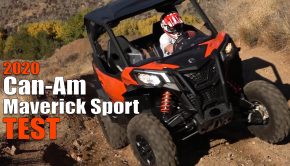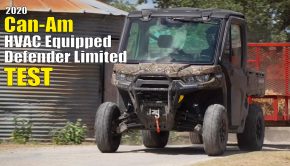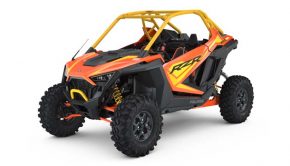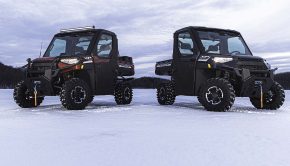Published on November 7th, 2019 | by Joe
2020 Kawasaki Teryx KRX 1000 Test: WITH VIDEO
2020 Kawasaki Teryx KRX 1000 Ratings
Summary: The KRX 1000 delivers strongly when it comes to handling, suspension, terrain-ability, comfort, and attention to detail. It’s hard to put a value on having the transmission, clutching, drive components and bodywork all built around the demands of larger tires. A CVT makes the KRX inviting for drivers of all skill levels. Front differential lock, the low power mode make the KRX a terrain conquering beast. Comparably, we feel the 2020 Kawasaki KRX 1000 offers a lot of features, performance, and potential for its $20,499 price tag and is a machine that many enthusiasts should be seriously considering.
4.3
3 Day Test
As time passes and the sport side-by-side segment continues to grow, so does the anticipation for long-standing manufacturers to enter the market. September 7th, at their dealer meeting in Palm Springs, Kawasaki gave the world their first up close look at the highly anticipated, all-new 2020 Teryx KRX 1000.
For our first go-round with the machine, members of the media were invited out to experience Kawasaki’s dealer meeting, interact directly with the product development team, and drive the new KRX for a few hours leaving us with nearly as many questions as answers.
One week later, the time had come to put the KRX to a proper test with two days of hard driving in the desert and rock trails of Moab, Utah. Ed Teixeira, owner of Teixeira Tech Chassis Components, test drove Yamaha’s seriously improved 2019 YXZ1000R for us, which has been winning shootouts against Honda’s new Talon models, making Ed an ideal test pilot for the KRX. Finally, it’s time to move beyond all of the dozens of annoying bias dealer and speculative videos from those who haven’t even driven the machine, as we bring you our test of the 2020 Kawasaki Teryx KRX 1000.
Engine

Powering the new KRX is a brand new, Kawasaki built, naturally aspirated, liquid-cooled, 999cc engine, the compact parallel twin-cylinder design featuring four valves, and double overhead cams per cylinder.
Powering the new KRX is a brand new, Kawasaki built, naturally aspirated, liquid-cooled, 999cc engine, the compact parallel twin-cylinder design featuring four valves, and double overhead cams per cylinder. A patent pending counter balancing system further contributes to its compact dimensions. Bore and stroke numbers measure in at 92 x 75mm with a compression ratio of 11.5:1. Air for the engine passes through a Donaldson paper filter located behind the driver’s seat featuring tool free access for easy maintenance. Fuel is drawn from an industry leading 10.6 gal. fuel tank fed by fuel injection via dual 50mm throttle bodies.

Kawasaki is the only Japanese manufacturer currently utilizing an automatic CVT transmission in their high-performance SXS. It features a centrifugal clutch to modulate power on takeoff providing constant belt tension for reduced wear.
Kawasaki says the engine was tuned for high-revving power and strong low-RPM torque. They’re claiming maximum torque of 76.7 foot pounds at 7000 RPMs and horsepower is listed at 112.6 according to CARB. Standard and low power modes are accessed via a dash mounted switch. The low power setting is said to limit the engine to around ¾ total power with a delivery smoothed out off the bottom to reduce unwanted pedal input.
Kawasaki is the only Japanese manufacturer currently utilizing an automatic CVT transmission in their high-performance SXS. It features a centrifugal clutch to modulate power on takeoff providing constant belt tension for reduced wear. A CVT temperature gauge on the cockpit’s digital display shows up to 6 bars. The temperatures range between 104° Fahrenheit for bar 1 and 230° for bar 6. All 6 will start blinking at 239°, letting you know you had better back off. We never managed to get the CVT temperature above two bars at 158 and there were zero belt failures among the group, so we suspect that belt durability won’t be of great concern for KRX owners.
The transmission features high and low forward ranges plus neutral and reverse. We wish it offered a park in the transmission in addition to its effective parking brake. Engine braking is standard.
In addition to mounting the pre-filtered intakes for the engine and CVT high on the rear fenders to minimize water and dust intrusion, Kawasaki added an easily removable drain plug on the bottom of the CVT’s . A sight window on the opposite side of the engine is used to check oil level instead of a dip stick. Kawasaki also worked to make the oil fill, oil filter, and CVT easily accessible.
The KRX drive system has on-the-fly selectable 2WD, 4WD, and 4WD with front differential lock. The axles and CV joints appear massive!
Power is strong off the bottom pulling hard on takeoff and out of low speed corners. It also makes things easier when crawling up steep inclines.
As speeds increase, the strong low-end is followed by a somewhat mellow midrange. The engine keeps pulling, but not with the authority it exhibits down low. Just as you begin to think that the engine is a bit underwhelming, it wakes back up, building RPMs more quickly with a surge of top-end power. We had the KRX up to around 66 mph, running out of room before we ran out of power. We have heard that top speed is restricted to around 68mph, which the aftermarket will undoubtedly bypass.

The strong low-end power is followed by a somewhat mellow midrange. Just as you begin to think that the engine is a bit underwhelming, it wakes back up, building RPMs more quickly with a surge of top-end power.
With a very robust looking build and massive 31” Maxxis Carnivore tires mounted on 15” beadlock wheels, the KRX engine is pushing around more weight than its competitors making it more of an endurance racer than a drag racer in stock trim.
In low power mode in low range, acceleration is extremely gradual up to two mph, remaining pretty mellow from there. In lower power mode in high range, acceleration is extremely gradual up to 6mph. Low power mode seemed to eliminate unwanted abrupt throttle inputs and the increase in traction and reduction in unwanted slippage on steep climbs is rather remarkable.

In low-range, engine braking makes the brake pedal an afterthought unless you want to come to a complete stop. In high-range
In low-range, engine braking makes the brake pedal an afterthought unless you want to come to a complete stop. In high-range, engine braking was far mellower as we’d like for high-speed driving.
With two-wheel-drive for getting sideways, four-wheel drive aiding traction everywhere, and front differential lock for times when you need every bit of available traction, we can’t ask more from the drive train.
Chassis and Suspension
The KRX is built on a brand new tubular steel chassis utilizing an 8-point ROPS cage with all points tying in directly with the main fame for added strength and rigidity. The entire underside of the main frame is protected by a combination of plastic and steel skid plates, with steel plates helping guard the cabin’s footwell area. The underside of the chassis is angled upwards on the sides for improved clearance.

The KRX is built on a brand new tubular steel chassis utilizing an 8-point ROPS cage with all points tying in directly with the main fame for added strength and rigidity.

With 24 way compression adjustable Fox Podium 2.5 shocks, 18.6” of wheel travel front and 21.1” rear. That’s 9/10” more front travel and 1” more rear travel than the KRX’s most similar competitor, the Honda Talon 1000R.
Dual A-arm suspension is used up front. A four-link trailing arm design is used out back, designed to offer more consistent tire toe-in over the suspension stroke for stable, predictable handling. High clearance lower arms are used up front with curved high-clearance trailing arms and radius rods out back. Ed was impressed with how overbuilt the different chassis components appear in comparison to other brands he’s developed parts for.
Fox Podium 2.5 LSC shocks with dual rate springs are used at both ends. Steel sleeves were added to the rear shocks to help protect the bodies. They feature spring preload, spring crossover, and 24-position low-speed compression damping adjustment controlling 18.6” of wheel travel front and 21.1” rear. That’s 9/10” more front travel and 1” more rear travel than the KRX’s most similar competitor, the Honda Talon 1000R. Sway bars are found at both ends to help control body roll. Electric power steering is tuned for greater assistance while stopped and at lower speeds, with a reduction in assistance at higher speeds where steering is lighter. It’s also drive mode sensitive with separate maps for two and four-wheel drive.
The KRX comes setup square with the same sizable 31×10-15 Maxxis, Carnivore tires mounted on equal offset, 15” aluminum beadlock wheels at all four corners, allowing you to swap front and back wheels in the event of a flat. The KRX tires protrude at both ends, providing 90 degrees of approach and departure angle.

The KRX is a claimed 68.1” wide with a 98.8” wheelbase and 14.4” of ground clearance. The KRX comes setup square with the same sizable 31×10-15 Maxxis, Carnivore tires mounted on equal offset, 15” aluminum beadlock wheels at all four corners,
The KRX is a claimed 68.1” wide with a 98.8” wheelbase and 14.4” of ground clearance. This puts it in the same width range as the Honda Talon 1000R, but with a 6.1” longer wheelbase and 1.4” more ground clearance. Surprisingly, Kawasaki is claiming a 19.4’ turning radius, compared to 21.3’ on the Talon R. Despite its higher ground clearance, the KRX is ½” shorter overall at 75”.
Curb weight is around the heaviest we’ve seen for a two-seat sport SXS at 1896.3 lbs. However, that could mean it’s one of the most durable, and weight starts adding up quickly on the competition when you start adding parts to beef them up. If power to weight ratio is of great concern, there’s already an aftermarket company working on a turbo kit.

Chassis and suspension performance are a cut above the stock engine power output. This allows skilled drivers to take full advantage of the available power, It also keeps novice drivers from getting in over their heads as easily.
Chassis and suspension performance are a cut above the stock engine power output. This allows skilled drivers to take full advantage of the available power, making for a machine that’s fun to drive hard. It also keeps novice drivers from getting in over their heads as easily. Out of the box, the KRX shocks do everything well, striking a good balance between bump absorption and bottoming resistance. We framed out on a couple mildly rutted high-speed G-outs, but never felt a bottoming sensation from the shocks.

Thanks to its long wheelbase and well-tuned suspension with plenty of travel, the KRX tracked straight and predictably in the high-speed whoops we encountered.
Thanks to its long wheelbase and well-tuned suspension with plenty of travel, the KRX tracked straight and predictably in the high-speed whoops we encountered. Backing off on the shock’s compression takes more of the edge off the sharp high-speed hits, although going too far will introduce body roll in corners. In rough, high-speed stuff, the back end of the KRX felt a bit loose initially. Dropping rear tire pressure from 17 to 14lbs had the rear end hooked up and driving nicely.
With stock shock settings, the KRX has very little body roll encouraging you to corner aggressively, although the harder you corner, the more you notice a bit of front-end push in loose terrain. Running limited-slip 4wd reduced this noticeably. Ed backed from 12 to 16 slicks out on the front shocks’ compression damping, which allowed a bit more weight transfer improving grip and yielding a KRX that can corner aggressively with good predictability.

With stock shock settings, the KRX has very little body roll encouraging you to corner aggressively, Power steering is well balanced with light steering and minimal bump feedback, feeling natural and predictable at various speeds.
For rock crawling on day two where high-speed corners weren’t a factor, Ed softened compression to 22 clicks out all-around for improved compliance and small bump absorption, which worked well. Based on our limited shock tuning, we’re pretty confident that with time to tune preload and crossover settings, we’ll be able to extract even more plushness without affecting the machine’s solid handling.
Power steering is well balanced with light steering and minimal bump feedback, feeling natural and predictable at various speeds. Steering effort remained very consistent in the different drive modes, only stiffening up a bit near full lock in 4wd with the front differential locked.

The sizable 31” Maxxis Carnivore do well at masking making many smaller bumps disappear with their increased rollover.
The sizable 31” Maxxis Carnivore do well at masking making many smaller bumps disappear with their increased rollover. They delivered excellent traction in the rocks and worked well in the sandy desert despite some low-speed chatter. Their willingness to hook up or slide on demand provided predictable control over the machine in the varying dry conditions we encountered. Over the course of two days, none of the dozen plus cars in our group suffered a flat. Unless you’re a mudder, it’s unlikely that you’ll be looking to upgrade tires very soon.
Brakes
Slowing the big Kawie are disc brakes at all four corners with dual-piston calipers front and single-piston calipers rear. Braking bias is said to be tuned with a slight bias toward the front maximizing power and traction.
Braking power and feel were both very good, easily overcoming the weight of the car and its burly wheel and tire setup. Braking balance is well dialed, with both ends hooking up well.

Braking power and feel were both very good, easily overcoming the weight of the car and its burly wheel and tire setup. Braking balance is well dialed, with both ends hooking up well.
Interior
The KRX Cockpit is spacious and easily accommodates occupants of various sizes. Offering plenty of room to enter and exit, high, half doors with handles inside and out, and built in arm rests feel well built.
On technical climbs and descents, the sight line out the front of the KRX is slightly inhibited by the higher points on the sides of the hood, making us appreciate how easily we could sight the front tires out of the side of the cabin. The sightline out of the back of the machine is pretty uninhibited.
Both the driver and passenger benefit from automotive style adjustable bucket seats with 6” of movement front to back. Their nice covers look like they belong in an overpriced special edition model. Their seats are pretty comfortable, although a bit more bolstering would be nice in a high-performance machine.
Ed felt the kick-up on the left side of the floorboard was a bit too close in relation to the gas and brake pedals, leaving his supporting leg notably more bent than the other when supporting himself on downhills.

Both the driver and passenger benefit from automotive style adjustable bucket seats with 6” of movement front to back.
Three point seat belts hold the driver and passenger in place with no uncomfortable contact points that we’ve experienced. The gated gear selector is well placed and worked predictably at full-stop. Gas and brake pedals were well within reach, but those with larger feet may wish for a bit more room between the pedals.
The ergonomically comfortable steering wheel is tilt adjustable offering plenty of movement. With the digital instrument display mounted on the steering Column, its angle changes with the steering wheel. It has variable brightness display with 23 different readouts, including the CVT temp gauge we mentioned earlier.
Power is available via a 12 volt outlet. The T-shaped passenger grab handle is reach adjustable, with the locking mechanism located in the passenger glove box, keeping away from mud and grime. Multiple glove boxes are located in the dash, along with a large box and additional storage located behind the seats along with 5 cup holders. With the seats all the way back, there was still enough room behind them for items like backpacks; unfortunately, a roof is an accessory add-on.
Additional Details
The rear cargo bed’s 351 lb capacity is the highest we’ve seen on a sport SXS and offered plenty of room for a 31 ” spare tire. A recessed bottom and integrated tie-down hooks make securing cargo easier.
LED lights are used at all four corners. The front end features both high and low beams with LED position lamps adding to the aggressive look.

he rear cargo bed’s 351 lb capacity is the highest we’ve seen on a sport SXS and offered plenty of room for a 31 ” spare tire.
Accessory Integration
Kawasaki had over 50 different accessories available at the time of launch. Instead of offering a bunch of different models for specific uses, Kawasaki is offering accessory packages, which can be pre-installed by your dealer. Packages can be stacked together or there’s the “I Want It All” package, which combines 31 accessories from the other packages to create the ultimate factory- accessorized KRX, taking the machine’s base price of $20,499 up to $29,387.95, with most of the other packages costing considerably less. Kawasaki’s accessories can also be purchase individually as well.
Conclusion
We can see adding more power to the KRX for racing, climbing steep dunes, or just upping the thrill factor another notch. The chassis and suspension certainly feel fully capable of dealing with it. If appearance holds true, the KRX could be one of the toughest Sport SXSs on the market, a capable weekend warrior and a great candidate for building a race machine.
The KRX delivers strongly when it comes to handling, suspension, terrain-ability, comfort, and attention to detail. The tire and wheel package is a $1,500 to $2,000 initial upgrade for many and it’s hard to put a value on having the transmission, clutching, drive components and bodywork all built around the demands of larger tires. A CVT makes the KRX inviting for drivers of all skill levels. Front differential lock, the low power mode and all the before mentioned attributes make the KRX a terrain conquering beast. Comparably, we feel the 2020 Kawasaki KRX 1000 offers a lot of features, performance, and potential for its $20,499 price tag and is a machine that many enthusiasts should be seriously considering.

The KRX delivers strongly when it comes to handling, suspension, terrain-ability, comfort, and attention to detail. Comparably, we feel the 2020 Kawasaki KRX 1000 offers a lot of features, performance, and potential for its $20,499 price tag and is a machine that many enthusiasts should be seriously considering.











